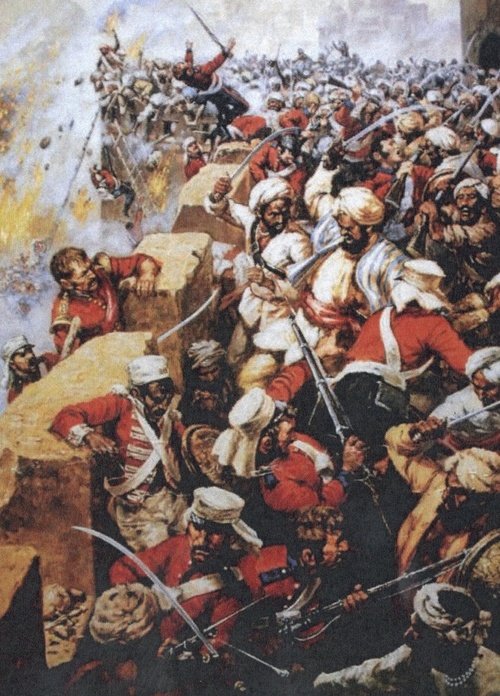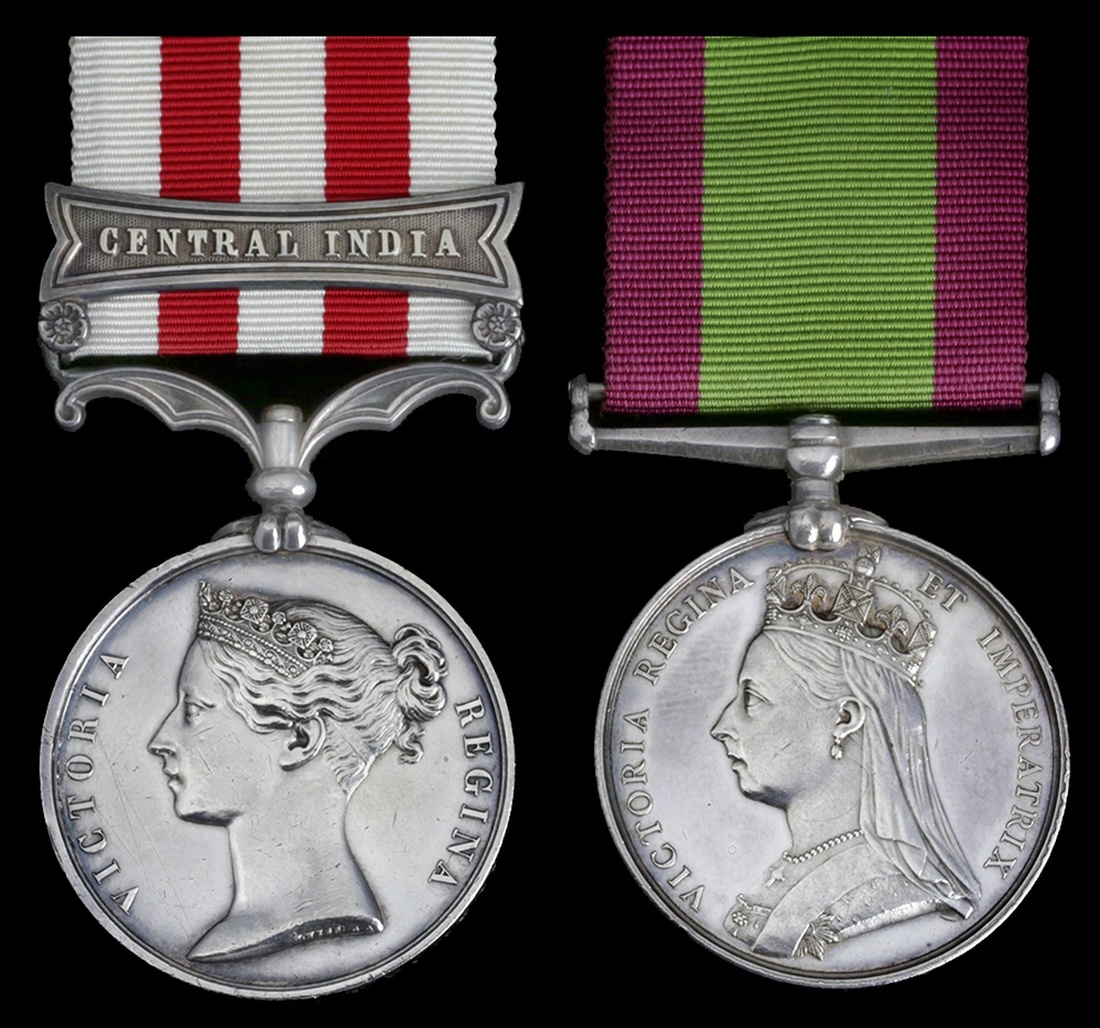Auction: 18003 - Orders, Decorations and Medals
Lot: 314
(x) The important Indian Mutiny and Second Afghan War pair awarded to Colonel W. T. Mills, 30th (late 25th) Bombay Native Infantry; having disarmed the mutinous Hyderabad Contingent at Aurangabad, Mills took part in Sir Hugh Rose's famous assault on Jhansi and was twice recommended for the V.C.
Indian Mutiny 1857, 1 clasp, Central India (Lieut. W. T. Mills, 25th Bombay N.I); Afghanistan 1878 (Lt. Col. T. Mills. 30th. Bo.N.I.), the first with light scratches to obverse and reverse fields, both better than very fine (2)
William Thomas Mills was born at Stepney, London c. 1833, the son of Henry Mills, secretarial Assistant to James Cosmo Melville, Director of the East India Company. Educated at Stepney Grammar School, young William was nominated for a Cadetship with the Bombay Infantry by George Lyall, another E.I.C. Director. Lyall wrote earnestly to Henry Mills:
'It is a source of personal gratification to me that I have this opportunity of promoting the views of so old a servant of the Company.'
William Mills passed his examination at East India House, Leadenhall Street on 11 December 1850. He was already capable of reciting Shakespeare in Hindustani, having studied at Mr. Howard's School throughout 1850. He embarked for India aboard the steamer Indus, which departed Southampton on 20 January 1851. On arrival he was commissioned an Ensign with the 9th Bombay Native Infantry.
Mills transferred to the 25th Bombay Native Infantry on 24 November 1855, with the rank of Lieutenant. This regiment was stationed at Ahmedabad on the North-West Frontier during 1856, and was due to support Major-General Sir James Outram's force in the Anglo-Persian War. Before the regiment marched, however, an uneasy peace was concluded with Persia under the Treaty of Paris (4 March 1857). This armistice came just in time for the British, enabling troops to be diverted to India for the forthcoming struggle.
Central India
On 8 June 1857, the 25th left Poona and rushed to Aurangabad, covering the distance of 138 miles in fifteen days. Aurangabad was the Headquarters of the mutinous Hyderabad Contingent, which the 25th quickly disarmed and punished. On 2 August the regiment relieved the British garrison at Mhow, which, under Captain Hungerford, R.A., had made a brave stand against overwhelming numbers.
The 25th then became part of the Malwa Field Force under Colonel Mortimer Durand. Durand invested the fortress of Dhar, held by a rebel Mahratta Raja, on 25 October. Though breaches were made on 31 October, the garrison fled before the stormers arrived. Durand pursued the mutineers across the River Chambal, making contact with them at a village called Goraria. The 25th led the British advance. One of its Sepoys, Private Dariyal Singh, rushed out and bayoneted a mutineer who was in the act of cutting down his Commanding Officer, Major Robertson. Robertson promoted Singh to Lance-Naik on the spot, laying his sword on his shoulder. Not one Sepoy of the 25th Native Infantry joined the rebel cause: all remained loyal to their British officers.
With the victory at Goraria, the rebellion in Malwa was stamped out; Durand prevented the Malwa mutineers from reaching the Deccan. In late November, the 25th joined Sir Hugh Rose's Central India Field Force, based at Mhow. Rose's column would sweep through Central India, crushing any resistance, before investing the great fortress of Jhansi. The 25th formed part of Brigadier-General Stuart's Brigade, which left Mhow on 10 January 1858. Stuart's first objective was the fortress of Chanderi in Gwalior. The 25th acted as an advance guard, seizing a narrow pass known as the Khatti Ghat. Alongside the 86th Foot, the 25th led the assault on Chanderi on 17 January, seizing the fortress by escalade. In his report to Sir Hugh Rose, Stuart praised the regiment's gallantry:
'Nothing could exceed the brilliant courage displayed by both Officers and Men of Her Majesty's 86th Regiment and the 25th Regiment Native Infantry. Colonel Sowth, commanding the former, and Major Robertson, the latter regiment, led their men in the most gallant manner, and I felt that, with such troops and so commanded, success, however we might be opposed, was certain.'
Storming of Jhansi
Stuart's Brigade rejoined Sir Hugh Rose's column for the march on Jhansi, which was reached on 10 March. A formidable stronghold built of granite, Jhansi was the seat of a Mahratta Rani whose lands had been confiscated by Lord Dalhousie, the former Governor-General. Jhansi's garrison numbered 11,000. The surrounding countryside had been laid waste, denying supplies to the British.
The moment Rose arrived at Jhansi, he received the alarming news that Tantia Tope, a rebel general, was marching to Jhansi's relief with 22,000 men and 28 guns. Rose knew that if he raised the siege in order to confront Tantia Tope, the garrison of Jhansi would sally forth and attack his rear. Leaving the bulk of his army to contain the city, he engaged Tantia Tope on the River Betwa with just 1,500 men. Mills was present at this action, the 25th Native Infantry forming the skirmish line. The 25th captured six enemy guns, and Tantia Tope was decisively beaten. Showing 'gallantry under fire', Mills was recommended for the Victoria Cross by Major Robertson (L/MIL/12/96). He bravely cleared a body of the enemy from a defensive position in a mass of rock.
At the storming of Jhansi on 3 April, the 86th Foot and 25th Native Infantry formed the left attack. Mills was again recommended for the Victoria Cross, this time for rescuing a wounded man of the 86th Foot under heavy fire. At great cost, the two regiments crowned the breaches and a ferocious mêlée ensued. Having gained the upper hand, they went to assist the right attack, which was foundering under murderous rebel fire. At length, the besiegers formed up inside the city and advanced through labyrinthine streets towards the Palace, which was taken room-by-room at the point of the bayonet. The Rani fled to Jhansi's inner fortress, which the British shelled continuously the following day. On 5 April the inner fortress surrendered; British losses in the assault were 37 officers and 307 men killed.
At the storming of Jhansi on 3 April, the 86th Foot and 25th Native Infantry formed the left attack. Mills was again recommended for the Victoria Cross, this time for rescuing a wounded man of the 86th Foot under heavy fire. At great cost, the two regiments crowned the breaches and a ferocious mêlée ensued. Having gained the upper hand, they went to assist the right attack, which was foundering under murderous rebel fire. At length, the besiegers formed up inside the city and advanced through labyrinthine streets towards the Palace, which was taken room-by-room at the point of the bayonet. The Rani fled to Jhansi's inner fortress, which the British shelled continuously the following day. On 5 April the inner fortress surrendered; British losses in the assault were 37 officers and 307 men killed.
Rose pursued Tantia Tope and the Rani of Jhansi to Gwalior, seizing the rebel arsenal at Kalpi. The Rani was captured by the 8th Hussars on 6 June, effectively concluding the Central India campaign. For his bravery in the assault on Jhansi, Mills received a special mention in the despatches of Brigadier Stuart (London Gazette, 10 August 1858).
Afghanistan
Mills transferred to the 30th Bombay Native Infantry after the Mutiny, promoted to Wing Commander on 1 July 1865. He served as Lieutenant-Colonel of the regiment during the 2nd Afghan War of 1878-80 (medal), when the regiment was initially stationed at Quetta. The 30th formed part of the Kandahar Field Force under Lieutenant-General Sir Donald Stewart, which protected lines of communication.
Whilst on furlough in England, Mills married Louisa Carver, daughter of the architect Richard Carver, at St. Matthew's Church, Bristol on 26 October 1872. They had three children, and lived at Gore House, Uffculme, Devon. Mills retired on 20 November 1879 with the rank of Honorary Colonel. He died at Gore House on 7 May 1901; sold with a file of copied research, artwork, V.C. recommendations and photographs.
Subject to 5% tax on Hammer Price in addition to 20% VAT on Buyer’s Premium. For more information please view Terms and Conditions for Buyers.
Estimate
£2,400 to £2,800







